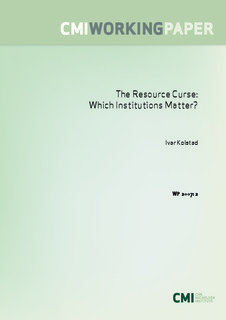The Resource Curse: Which Institutions Matter?
| dc.contributor.author | Kolstad, Ivar | |
| dc.date.accessioned | 2007-08-14T11:01:50Z | |
| dc.date.accessioned | 2017-03-29T09:13:27Z | |
| dc.date.available | 2007-08-14T11:01:50Z | |
| dc.date.available | 2017-03-29T09:13:27Z | |
| dc.date.issued | 2007 | |
| dc.identifier.isbn | 978-82-8062-172-6 | |
| dc.identifier.issn | 0804-3639 | |
| dc.identifier.uri | http://hdl.handle.net/11250/2436140 | |
| dc.description.abstract | Two types of models are dominant in the current resource curse literature. One type of model studies the selection of entrepreneurs into rent-seeking versus productive activities. The other type analyzes the use of patronage by politicians seeking re-election. The policy implications of the two models are quite different. The first model suggests that institutions governing the private sector ought to be improved. The second that institutions governing the public sector should be emphasized. This paper empirically tests the impact of the private versus public sector institutions on the resource curse, using cross-country data from Sachs and Warner (1997a) and Polity IV. The main result is that only improved private sector institutions ameliorate the resource curse. | |
| dc.language.iso | eng | |
| dc.publisher | Chr. Michelsen Institute | |
| dc.relation.ispartofseries | CMI Working Paper | |
| dc.relation.ispartofseries | WP 2007: 2 | |
| dc.subject | Natural resources | |
| dc.subject | Resource curse | |
| dc.subject | Institutions | |
| dc.title | The Resource Curse: Which Institutions Matter? | |
| dc.type | Working paper |
Tilhørende fil(er)
Denne innførselen finnes i følgende samling(er)
-
Bora-import [434]
